Editor’s note: Stanford University is hosting a brand-new class this fall—Technology, Innovation, and Modern War. Steve Blank, who teaches the course along with Joe Felter and Raj Shah, is writing about each class session—offering Modern War Institute readers an incredible opportunity to learn about the intersection of technology and war and hear from remarkable guest speakers. Read about previous sessions here, here, and here.

Class Seven
Today’s topic was military applications of artificial intelligence.
If you can’t see the slides above, click here.
Our guest speaker was retired Lt. Gen. Jack Shanahan, former director of the Joint Artificial Intelligence Center (JAIC).
Some of the readings for this class session included: “Can The Pentagon Win The AI Arms Race?,” “The Ethical Upside To Artificial Intelligence,” “The Coming Revolution In Intelligence Affairs,” “Artificial Intelligence For Medical Evacuation In Great-Power Conflict,” and “Artificial Intelligence And National Security.”
AI and the Department of Defense
As a lead up to this class session we’ve been talking about the impact of new technologies on DoD. AI is constantly mentioned as a potential game changer for defense.
Lt. Gen. Shanahan founded the Joint Artificial Intelligence Center to insert AI across the entire Department of Defense. The goal is to use AI to solve large and complex problem sets that span multiple services; then, ensure that all of DOD has real-time access to libraries of data sets and tools. A key part of the strategy was to work with commercial companies to help build these solutions.
Prior to the JAIC, Lt. Gen. Shanahan ran Project Maven, an unintentional dry-run for how DoD and commercial companies could partner (or not) to build AI-enabled apps. Maven partnered with Google to build a computer vision tool for imagery analysts to automatically detect objects/targets. The relationship ended when Google employees forced the company’s withdrawal from the project.
There were lots of lessons on both sides—about transparency, about why companies in the twentieth century had “federal systems divisions” that worked exclusively on government projects, while the rest of the companies pursued commercial business—as well as a lot of relearning lessons Silicon Valley had forgotten (see “The Secret History of Silicon Valley”).
This entire class session was a talk by Lt. Gen. Shanahan and Q&A with the students. It’s interesting to note how many of his observations echo ones Chris Brose and Will Roper made in the previous sessions.
I’ve extracted and paraphrased a few of his key insights below, but there are many others throughout this substantive discussion. I urge you to read the entire transcript and watch the video.
Tactical Urgency and Strategic Patience
We have a relatively small window to transform the Department of Defense from a set of Industrial Age, hardware-centric organizations to Information Age, software-centric, more risk-tolerant ones. That demands the right combination of tactical urgency and strategic patience, but there’s no question we have to move with alacrity on this right now.
War is a very uncertain endeavor run by humans. If we find ourselves on the verge of a conflict with China in twenty years, the idea that we might have a fully AI-enabled force by then will not by itself guarantee victory. If, on the other hand, in that same twenty-year period, China has a fully AI-enabled force and we do not, I believe we will incur an unacceptably high risk of defeat.
Project Maven: Start With the Problem—Automate Imagery Analysis
We didn’t start Project Maven with an AI solution. We started with a problem: far too much information coming in from intelligence, surveillance, and reconnaissance. It was done manually—intensive, mind-numbing work with analysts staring at video screens for twelve hours a shift. They couldn’t ever get through that much. It was really hard for analysts to absorb that amount of data and the data was increasing—in volume, speed, and tempo—and it was coming from all sources simultaneously, from unclassified to the highest classification levels.
We weren’t looking to do a 1x solution, a 5x solution, or even a 10X solution. We wanted a 100X solution. We needed something that would really change the way we did processing, exploitation, and dissemination of all this intelligence coming in from all these platforms and centers in the world.
We went out and solicited everything we could find in the Department of Defense. There was tremendous AI work going on in the research labs, but nothing available for doing processing, exploitation, and dissemination in the near term. The problem was that while the military research labs were doing some of the best research in the world, it wasn’t getting across the classic technology valley of death. (I like to talk about Maven and the JAIC as “AI Now,” and then places like DARPA and the military research labs as “AI Next.”)
Where else did this AI technology exist? DIUx, In-Q-tel, and others pointed out to us, “You lament about how much information you’re having to take in and process. Look at how much information YouTube takes in every single day. Your problems are not overwhelming. There are solutions available in commercial industry.”
So how do you take technology from commercial industry, adapt it for Department of Defense purposes, and do it fast enough and do it at scale across the entire department? The only way we could do that was to start bringing in those commercial technologies faster and faster.
So, Project Maven started us on the path of bringing an AI-enabled solution for the purpose of intelligence. It was largely computer vision in going after the intake from drones—at first tactical drones, then mid-altitude drones, eventually high-altitude, manned airplanes and even commercial imagery, working with the National Geospatial Intelligence Agency.
The JAIC: Go at Scale and Speed
After a couple of years of doing Project Maven, Bob Work (then-deputy secretary of defense) was itching to move just beyond intelligence. He said Maven was never designed to be only about the intelligence enterprise, we needed to bring in every single mission in the Department of Defense, and we needed to go much faster. There was a revolution happening in commercial industry and DoD was not was not getting it.
I was chartered to stand up the JAIC in a form that Joe and Raj, and I’m sure Steve, would appreciate. Somebody signed a memo saying, “Go stand up a joint AI center. You don’t have any people, you don’t have any money, you don’t have anywhere to live, but you’ll figure it out.”
Lean, MVPs, and DoD
Project Maven became the basis for what we did in the JAIC. We started with a cross-functional team. In commercial tech you call that an integrated product team—it’s acquisition with software engineering with user interface and user experience (UI/UX). This idea of UI/UX—a ruthless focus on user experience—DoD has never been very good at that.
It’s also learning how to put things on contract fast, get things done, and field them quickly. It was whatever you can do to get away from the classic DoD stovepipe way of doing business to a much more agile software approach.
Josh Marcuse and the Defense Innovation Board were instrumental in helping us see what those agile principles were and how we could get moving and go fast. And we took the classic commercial tech approach of building minimum viable products: get something that will work good enough, and let users know what they’re going to get as opposed to just forcing something down their throats and claiming that it was much better than it really was.
Minimum Viable Products
The idea of a minimum viable product (MVP) is not what the Department of Defense has lived with. It’s out there in pockets, but we need to be much better at that.
What’s “good enough” when we field these capabilities? It was never for us to say. It was for the users of the capabilities to tell us. We would give some parameters like, “This is a 95 percent test and evaluation solution. Do you accept it?” And they’d come back and say, “I don’t know. Let me try it out.”
The other reason that we wanted to push AI-enabled capabilities out to the field as quickly as possible is because until users get to play around with it, it’s just science fiction. You hear all these grandiose stories about what AI is. But few people are saying what AI is not. And in the Department Defense, it’s more about what it’s not than what it is.
There’s so much more we must do to get people to use those capabilities. As soon as they touch it, they say, “Well, if it can do that, what about this?” Every time they’ve said that, we said yes, it can be done. So we’ll make this product better and better in a rapid, agile approach of continuous integration and continuous delivery.
That is the future for the Department of Defense. If we don’t get that right, we’re doomed because AI capabilities left to themselves six months down the road will become useless. Just like any commercial software, it’s got to be a continuous development cycle. So that idea of MVP—putting capabilities in the users’ hands, letting them tear it apart and tell us what worked, what didn’t work, what they’d like to see better—that was really the core concept about Maven, and then the JAIC.
The idea of ops and intel working closer together, those two worlds merging, is the holy grail. These AI-enabled capabilities are getting us closer and closer to that environment. And this idea of a user-defined operating picture is with us today. The performance of that will increase exponentially over the next couple of years.
Continuous Integration, Continuous Development, Continuous Delivery
The other thing about AI is that you train it against one set of data that will reflect, to some extent, the real world. But once you put it in the real world you learn it never works as advertised. The first time you use it in Afghanistan you realize you never trained it against data that had women wearing full-length black burkas, and it didn’t know what those were. Interesting little problem. So you get real-world data, you feed it back into the algorithm, and it performs better and better. A second time, a third time, and so on and so on. It was all about the user defining what success looks like.
You need a cycle of continuous integration, continuous development, and continuous delivery.
We were proud at Project Maven that the first updates of our initial algorithms were out the door in four to five months and then got better and better—in some cases about every two weeks. In our personal lives, we get updates pushed to us hourly in some of our apps. So that’s the goal. To be able to do that, you need this back-end infrastructure and architecture, so that a soldier, sailor, airman, Marine, or Space Force member, wherever he or she is, can design an app on the spot, relying on this back-end infrastructure—the “Joint Common Foundation.”
We’re not close to doing that yet, with some very limited exceptions like Kessel Run, which is not AI, although they’re starting to go down that path, too. But they’re getting into that model of, “How quickly can I get this in an agile sort of software pathway of doing things and push it out to the field as quickly as possible?”
Warfighters Need to Be Demanding Customers
The biggest role that the warfighters have in this is to be very demanding customers and to say what needs to be fixed and not just accept what we’ve done to operators too many times, which is to essentially say, “Look, here’s the product, take it or leave it. We’re going to get you another version five years from now and probably $200 million over budget.”
That world is gone. We have got to get to that point where instead we can say, “Here it is. What’s wrong with it? We’ll fix it as quickly as we can and we’ll update it with real-world data to make it better and better.” Demanding customers provide ruthlessly candid feedback, which was never a problem with the special operations community.
This concept of leverage and UI/UX is so essential to everything we’re doing. And the back end requires things in addition to a common foundation. A data management platform, open API, all the T&E tools—everything should be available to everybody in the Department of Defense.
You Need a Disrupter
And then of course you need a classic disrupter. Somebody who does not take no for an answer, who breaks a little glass and makes some people a little bit upset in terms of overturning their apple carts. Because there are so many obstacles in the Department of Defense it would be easy to become disillusioned and just give up on the whole enterprise. The role I needed to play was top cover for the disrupter. It’s the combination of this top-down advocacy and pressure and this bottom-up innovation. And then you bring in a disrupter that gets this thing going.
This is what Raj Shah did at DIUx. It’s what AFWERX has to deal with. It’s what Hondo Geurts had to deal with when he was running SOFWERX. It’s what Enrique Oti has done up at Kessel Run, Chris Lynch at the Defense Digital Service. These were classic disruptors—strong personalities running innovation organizations in innovative ways.
Scaling the Organizations Across DoD
But now you had to take all those models and begin to learn, how do you scale them across the Department of Defense? That is incredibly hard. And that’s what the JAIC was designed to do—spark the movement for the next ten, fifteen, twenty years of movement.
But unless you take those organizational models and begin to scale them across the Department of Defense, they’re sitting there as one-off organizations. They’re critical but they’re insufficient. You need to inculcate a startup culture in the institutional bureaucracy of the Department of Defense.
One of the most important things we were working on in the JAIC is this thing, mentioned earlier, called the Joint Common Foundation.
Joint Common Foundation
The Joint Common Foundation is an architecture and infrastructure—for lack of a cleaner term, call it a platform as a service, a DevSecOps or AI/Ops environment, on top of an enterprise cloud environment that’s supposed to be called JEDI. To build this DevSecOps, AI/Ops environment means to give everybody in the Department of Defense equal access to everything from data, to AI tools, to all the security environment, to Jupyter notebooks, you name it, everything you would need to develop AI. The JAIC is building that as a common foundation.
There are two hundred people in the JAIC, and that includes contractors, so it’s probably not going change the entire Department of Defense and their AI way of doing business. But what it has to do is leverage more. The idea is that everything that JAIC does is a product available to everybody else in the Department of Defense. They come, pull it off the shelf, so to speak, and use that to leverage the entire Department of Defense. Otherwise JAIC will be an interesting organization and last for a few years and go away.
The Joint Common Foundation is designed to make that available to everybody across the Department of Defense. And I think over the next few years that Joint Common Foundation will be what the JAIC becomes known for as much or more than anything else it’s doing. The services will figure out the technology piece; it’s just that they need a little bit of a push, that flywheel has to get turning a little bit faster.
New Operating Concepts Versus Doctrine
Even more important than this is the idea of developing new operating concepts. New operating concepts do not come out of the Pentagon. The Pentagon writes great doctrine. Doctrine is all sorts of instructions and directives and great PowerPoint slides; the operating concepts will come from those on the tactical edge or the operational environment.
And what does the world of AI, enterprise cloud, 5G, and someday quantum look like? I don’t know, but it’s not for us to say, it’s for the users to be able to figure it out, by letting them try it out in operational settings. I believe there is no mission in the Department of Defense that will not benefit from the introduction of AI-enabled capabilities—from the back office to the battlefield, from undersea to outer space, in cyberspace and all points in between.
Read the entire transcript of Lt. Gen. Shanahan’s talk here and watch the video below.
If you can’t see the video of Lt. Gen. Shanahan’s talk click here.

Class Eight
Today’s topic was artificial intelligence and modern war.
Some of the readings for this class session included “What the Machine Learning Value Chain Means for Geopolitics,” “How Artificial Intelligence Will Reshape the Global Order,” “An Understanding Of AI’s Limitations Is Starting to Sink In,” and “The Panopticon Is Already Here.”
AI and The Department of Defense
In our last class session, Lt. Gen. Shanahan described the mission of the JAIC, which is to insert AI across the entire Department of Defense. He also said, “The most important hire I made in my time at the JAIC was the chief technology officer, Nand Mulchandani.” Nand changed the culture of the JAIC, bringing in Silicon Valley tools for product development and product management and for the first time a culture that focused on UI/UX, MVPs and continuous integration and deployment.
In this class session Nand, the JAIC CTO who just completed an extended stint as acting director, continued the discussion of AI and the role of the JAIC.
In addition to Nand, the class also heard from Chris Lynch, founder of the Defense Digital Service and now the CEO of Rebellion Defense, a new vendor of AI to DoD. One of the main purposes of the class is to expose our best and brightest to DoD challenges and inspire them to serve. Chris’s story of why he started the Defense Digital Service and how he built the team is a model for how you create a movement.
I’ve extracted and paraphrased a few of their key insights below, but there are many others throughout this substantive discussion, and I urge you to read the entire transcripts (here and here) and watch the video.
Nand Mulchandani
How the JAIC is Organized
The JAIC is a tiny team, yet we have a product directorate with thirty-two products that we’re building across six verticals—all the way from warfighter health to joint warfighting to business process automation, humanitarian assistance, disaster relief, cybersecurity, and predictive maintenance. And we own the AI autonomous weapon systems ethics and policy for DoD.
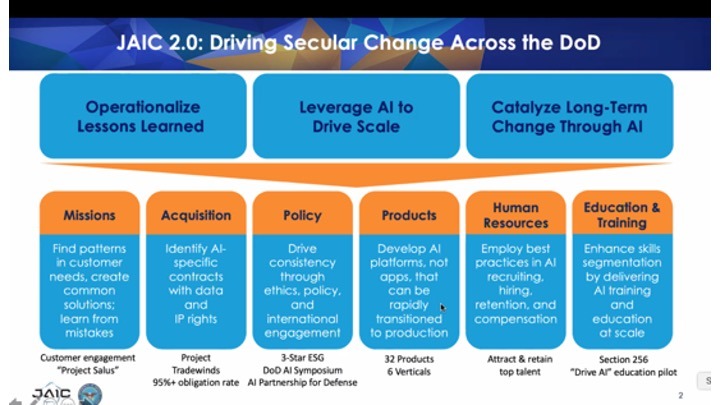
We have an acquisition arm and Congress is probably going to give us acquisition authority this year. And we have a missions team headed up by a one-star flag officer with six O-6 level officers (colonels and Navy captains) heading up the different missions.
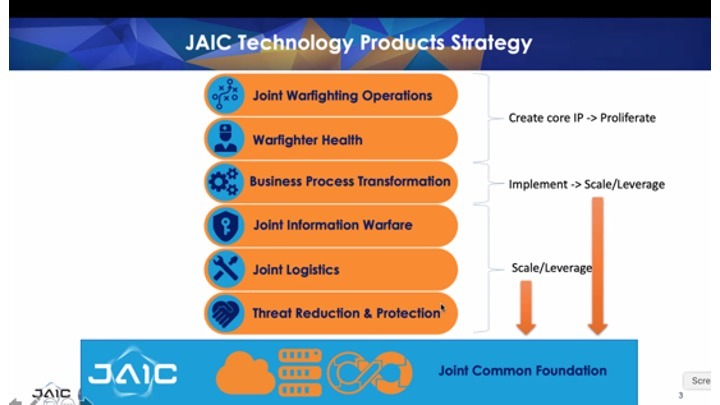
Selling JAIC like Enterprise Sales
When Lt. Gen. Shanahan brought me in a year and a half ago, we were focused on building one-off products that in some sense were what I called “using a peashooter against a tank.” One product at a time wasn’t going to change the trajectory of DoD. This is where I brought in the thinking of how we build businesses here in Silicon Valley. We needed to be building leveraged business models in scale. Leverage is a key part of how you change a three-million-person organization through technology.
Everything that we do at the JAIC has to be built and done with leverage in mind. I organized my missions team like an enterprise sales team. We took all the colonels and the captains and said, “You are now going out there and finding the repeatable customer patterns. You’re not finding the one-off custom projects to come build. Instead you need to find the patterns, where I can build a single piece of IP or technology and then ‘sell it’ to all the combatant commands and services equally.” Because doing one-offs is never, ever going to change DoD.
JAIC Is Applied AI—Focused on Impact
AI is not a single technology. It’s picked up every piece of technology in statistics and regression and we’re dealing with anything from string data to numeric data to audio to language to still imagery and full-motion video object recognition.
But we take this technology and apply it to a particular set of customer problems and focus on the impact. I take a very practical approach to this. I’m an entrepreneur and an implementation guy. So, my focus is on practical ways of moving this big rock, in a tactical, tangible way, slowly and surely, while big thinkers will the work on the broader theoretical pieces.
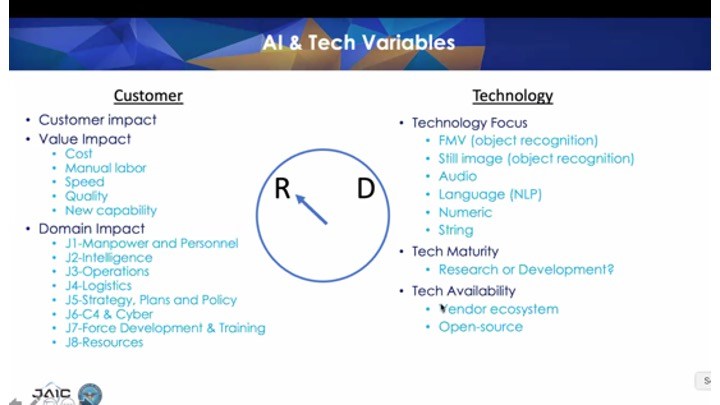
For instance, inside DoD we have aging equipment and we have a number of business processes that are really less than optimum. How do we tackle those with AI so they become quick wins and so that success begets success?
However, using AI for new warfighting capability—that’s much, much more complicated. That’s the stuff that Rebellion and Anduril and a number of other companies are helping us with.
Connecting Systems End to End
We’re applying AI across the board. Take a look at the diagram below. On the left is the Pentagon with highly connected data centers with high bandwidth. And on the right, you’ve got the tactical edge, where we’ve got UAVs, tanks, spacecraft, etc.
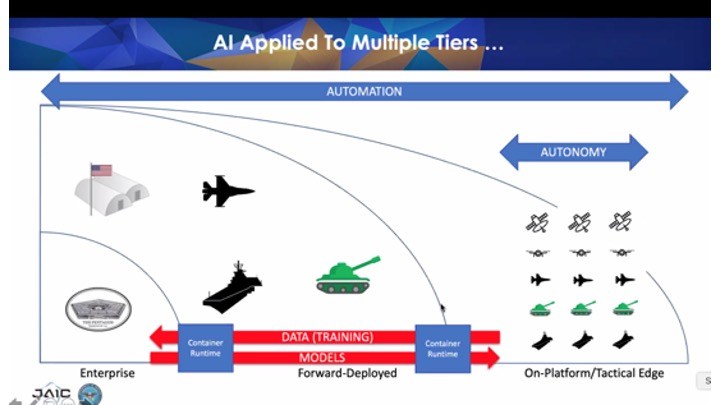
At the JAIC we’re focusing on what we call the autonomy space—close combat, AI for small-unit maneuvers, around things for SOCOM, and what the Marines and others are going to have to do with the new National Defense Strategy and new operational concepts.
And then we’re also focused on autonomy. The magic words—Joint All Domain Command and Control (JADC2) and the Advanced Battle Management System (ABMS)—are the automation pieces. How do you connect all of our systems end to end? That requires targeting logistics, fires, everything else. Today, it’s a process that’s half manual, half PowerPoint, half Excel, half whiteboard, and half a bunch of lieutenants, majors, and colonels all drawing stuff and cobbling it together. If we agree that the next generation of warfare is going to be fought at the speed of software, you need these end-to-end systems all connected together in a backplane, a platform.
Now the problem is, in the diagram below on the left, this is what our DoD architecture looks like today. It’s a bunch of vertically integrated snowflake applications with a mouse and a keyboard and a screen. Applications are developed in silos, making it impossible to enable centralized functionality.
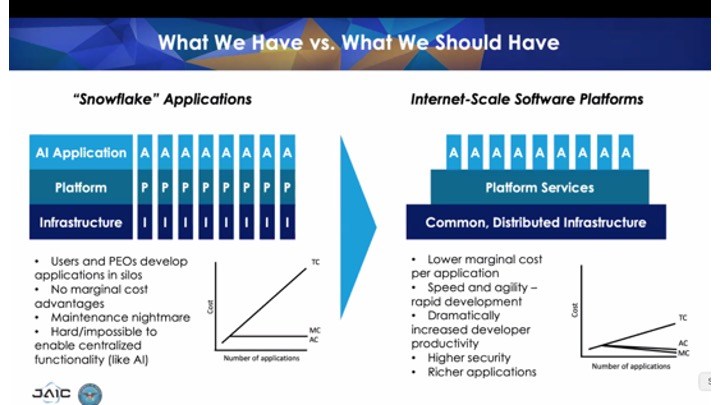
And for students of economics, you see the cost curve. The graph on the left just doesn’t work. Your marginal costs and your average costs of building software do not go down over time. What’s ironic is that software is one of the few businesses where the more you build, the cheaper it gets.
The curve you want is on the right—lower marginal cost per application, rapid development, increased developer productivity, etc. And the only way you’re going to get there is through building common platform services and the application architecture that internet-scale companies do today. And in DoD that discussion and those ideas are completely missing. And so we continue to build stuff as it is on the left. The discussion we’re having in the Pentagon is how do we move things from left to the right.
Moving from Vertical Silos to Horizontal Platforms Enables “Software-Defined Warfare”
Our observation is that the architecture of DoD systems is vertically scaled. What that means is that for that last few decades the goal for every weapon system is about how does each generation get a bigger and bigger version of the same weapon system?
Today that means we just made our targets bigger for our adversaries. Think of a giant aircraft carrier sitting out in the ocean with a hypersonic missile targeted against it. It’s like a giant, vertically scaled data center that we used to have fifteen, twenty years ago. The architecture changes we need to make in our design for the next-generation combat systems are precisely the same things that we had to do to change the way we operated data centers. Which is moving from stateful, long-running, individual systems to horizontally scaled, stateless systems. We need them attritable, able to work in denied and degraded environments.
This is what we’re thinking when we call it “software-defined warfare.”
However, AI as a services-oriented architecture has to get built out on top of an infrastructure platform. The biggest problem is that no one in DoD owns running that. So while others can run the JEDI cloud for DoD, nobody owns running application services for DoD. And the JAIC can’t run them because we’re not an operational software organization.
Joint Common Foundation
One of the biggest mandates we’re focused on now is the Joint Common Foundation, the JCF. It’s an AI development and data environment for DoD that democratizes access to compute and data.
The vision is a tactical team sitting out in one of our remote bases. Imagine if they can power up a secure laptop, crank out thirty lines of Python code, and grab a set of services—logistic services, mapping services, targeting services, etc.—that are available DoD-wide directly through the JCF. They crank out that code that they get into production, use it for a month, and then throw it away.
That is the reconfigurability and speed that we need to have at DoD. So if we are ever in combat, the reconfigurability of our infrastructure, whether it be hardware infrastructure at the tactical edge or back-end systems to react, that is the level of game that we have to have, or we’re toast. That’s it. It’s that simple.
Chris Lynch
The Culture of Change: Getting the Job to Run the Defense Digital Service
In 2015, the chief technology officer at the White House, Todd Park, mentioned I ought to meet with the Department of Defense, where leaders were thinking of creating the Defense Digital Service, a DoD version of United States Digital Service. The goal was to bring modern, private-sector tools, technology, and talent into DoD to solve high-impact challenges.
And Todd Park said, there’s going be a lot of people who want to do this, who want to lead innovation, and a lot of people are going to come through to pitch their version of it. I thought about the job like a startup. I came in with a pitch around a “SWAT team of nerds,” one that would work on problems of impact and things that matter. I remember the first time I walked into the waiting room for the Office of the Secretary of Defense. It felt like “Shark Tank.” There were a bunch of other people all going in to do their pitch and talk about their idea for what they wanted to build. Some of them had presentations, and all of them had things printed out of course, because it’s the Department of Defense. We’re talking about technology and innovative ideas, and doing things differently with technology and software, and of course, nobody was able to do an actual presentation with a computer.
I chose to show up that day representing what I thought had to be the culture from the very beginning. If we tried to build the bridge by being what they were, it wasn’t going to be right. It wasn’t going to be authentic. And we would never attract the best people into the most important mission in the entire world—the mission of defense and national security.
So I showed up in a hoodie and I showed up as me. I didn’t print off a presentation. I pitched the idea: let’s do the SWAT team of nerds. And I can remember it felt really, really, weird standing in that office with people in suits and people in uniform in the military. It was just such a different world, completely and totally unlike anything that I had ever seen.
And you know, that’s what they wanted. And that’s what I wanted to be in that part of the story. Because I felt it was important that we actually get people to show up to do the mission. I think that that’s probably one of the most critical things that became the basis of how I thought about what we were building.
Recruiting for the Defense Digital Service
I told people, I want you to leave your job where you’re paid more than what I’m going to pay you. I want you to leave your job, where you’re getting free meals, where you’re living and working around a bunch of other software engineers. And I want you to come into a place that is going to be so unbelievably difficult, frustrating, and sometimes demoralizing. I want you to come into that.
And I want you to give me six months to one year. But I also just want you to be you.
And when you leave, if you do your job here, if you do the thing that we showed up to do, and if we are successful in what we’re trying to accomplish, it will change your life until the day you die. You’ll never be able to get it out of your blood. And that’s the place that we built. I think that that’s the culture, I think that’s the right place to be.
Because it allowed us to show up in what we were comfortable wearing, we became known as the people in hoodies. And you would have the vice chairman of the Joint Chiefs of Staff doing a presentation for newly minted generals. And they would show a slide with a picture of me with orange tennis shoes on. And it just became our uniform. And it also made it really easy to be like, “Oh, that’s Chris Lynch. He’s a nerd, right? That’s the person that I want to talk to.”
And that was the culture that we decided to build. Just keep focused on results, not getting caught up in sizzle but in real things, in building real tangible stuff. And I think we were successful.
Starting Rebellion Defense
When I left the Defense Digital Service, I felt like I was standing at the shore of this vast sea of all the things that I might do next.
Rebellion Defense was built around the idea of “let’s do something spectacular.” Let’s continue that mission, but at a scale that would be impossible inside DoD. And we would be able to bring in incredible new people who wanted to work on something meaningful and impactful.
Surprises from Being Outside the Government and Selling In
It’s funny, one of the things I never had to worry about on the inside of the Pentagon was budget. As it turns out, finding who has a budget and can allocate funds is a lot more complicated than you’d think. Just because you find someone who has a budget, they have to find a contracting office to do the buy.
My second point is, if you simply believe that you’re going to show up with an awesome product and awesome technology, guess what: that doesn’t mean anything. If you’re selling this customer technology you already lost. DoD is a mission-driven organization—which means you have to understand what they are doing. If there’s a person saying, “Oh I need more AI and ML,” they’re likely not the person who has the budget at the end of the day.
Next, this space has a lot of companies in it that have been here for much longer than you. And you probably don’t know anybody in this space. They do. They know them all. They previously have occupied the jobs that the current people in those roles are doing. And so they have all those relationships. That’s a moat.
And incumbents and competitors say they do pretty much anything that you will say that you do. They’ll say, “AI and Machine Learning? We do AI/ML on quantum clusters with cheddar cheese.” And literally, I have had people who send me the most random word-salad construction of words and phrases, I don’t even understand what you’re saying. I get that all the time. I can’t tell you the weird stuff that I get sent my way.
So you have to find that partner that has a belief in solving a problem. They have to know what is real and what is not.
How Will AI Be Used? Why Should Silicon Valley Engineers and Our Students Get Involved?
We either show up or we cede our ability to influence and decide on that policy.
If the world’s greatest technologists do not show up and build the systems for the Department of Defense to lead in this area and decide the ethical and moral boundaries that we believe in, and that we as a nation are comfortable with, somebody else is going to show up and lead in the way that those technologies are built. And they will decide how they’re used and that will be the definition of ethics and morality.
So you have one very, very simple choice: show up. If you don’t show up, then you don’t get to play a part in the discussion. Because if other countries who do not share your beliefs become the leaders in how these capabilities are used in a military context and they deploy them, it doesn’t matter what you think. That becomes the norm.
I believe that technologists—people like you and people like me—we can’t give that up to somebody else. I don’t want somebody less capable than the best in this country to show up and build those systems.
Postscript
The Department of Defense awarded a $106 million contract to build the JAIC’s Joint Common Foundation to . . . Deloitte Consulting.
Read the entire transcript of Chris Lynch and Nand Mulchandani talks here and here and watch the video below.
If you can’t see the video click here.
Steve Blank is the father of modern entrepreneurship, an entrepreneur-turned-educator, and founder of the lean startup movement. He is an adjunct professor at Stanford and a senior fellow for entrepreneurship at Columbia University.
Image credit: Sgt. Richard Wrigley, US Army (adapted by MWI)


The delicious irony of reading this on the MWI website is illustrated by all the unavailable links featuring the USCYBERCOM seal and the statement, "You have attempted to access a blocked website. Access to this website is blocked for operational reasons by the DoD Enterprise-Level Protection System.
Chris Lynch's reminiscence about the Defense Digital Service brought a smile, too. My interaction with the DDS illustrates the untold part of so much of "fast acquisition" A DDS team showed up in our spaces one day, seeking to transition a sensor device they'd developed after roaming around in-theater talking to people…said device was inferior to the commercially-derived device we were already using, incompatible with the existing DoD data architecture, and buggy enough that it only functioned part time. They were at the end of their development cycle, though — what they wanted was to hand off this wonderful prototype for us to finish. I shudder at any offer of free "government-off-the-shelf"…TRL 6, no matter how interesting, is not operationally useful.